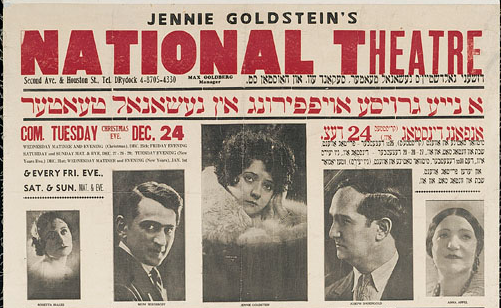In effect, Yiddish theater arrived in New York City in its infancy and was nurtured there at the turn of the century by its greatest audience — the largest, most heterogeneous aggregation of Jews in the world. In the early years in America, the Yiddish theater overflowed with “corrupt and foolish versions” of the European repertoire as well as “vivid junk and raw talent.” It took hold in the public mind only after many trials. But with the emergence of playwrights like Jacob Gordin and actors like Boris and Bessie Thomashevsky and Jacob Adler, larger and larger audiences were attracted.
By 1900 there were three major theater troupes in New York City and numerous smaller endeavors in other Jewish population centers. From the late 1890s to World War I, the works of Shakespeare, Ibsen, and Strindberg were adapted to the needs of the immigrant culture, and a flamboyant style of acting was developed. One critic observed that, more than anything else, Yiddish theater, with its overstatement and ritual pageantry, resembled Italian opera without singing.

The theater came to enjoy an unrivaled position on the Lower East Side; it became a major cultural institution, in which all the problems, hopes, and dreams of immigrant Jews were dramatized. The Yiddish theatre provided a collective experience for the entire community.
With your help, My Jewish Learning can provide endless opportunities for learning, connection and discovery.
It was also a powerful vehicle for fundraising. Philanthropic, mutual-aid, and labor organizations often sponsored benefit performances. Ticket prices ranged from 25 cents to a dollar, not a small outlay for immigrant laborers, but somehow thousands managed to pay it.
By 1918 the city boasted 20 Yiddish theaters, which, in a single year — before the inroads of movies –attracted two million patrons to over a thousand performances. Hutchins Hapgood, a keen and sensitive observer and devotee of East Side culture, wrote that Jews of every station and persuasion came to the theater: “The Jews of all the ghetto classes — the sweatshop woman with her baby, the day laborer, the small Hester Street shopkeeper, the Russian Jewish anarchist and socialist, the ghetto Rabbi and scholar, the poet, the journalist. The poor and ignorant are in the great majority, but the learned, the intellectual, and the progressive are also represented.”
Although Jewish intellectuals and socialists considered the Yiddishized classics, along with the musical melodramas of Joseph Lateiner and Morris Horowitz, to be shunde (trashy), the practice of adaptation led the way to better drama on the Yiddish stage. Jacob Gordin began in 1890 to reform the Yiddish theater according to the best traditions of the Russian theater. He succeeded, to some extent, in educating actors and audiences to appreciate sincerity on the stage. But the playwright was also influenced by theatergoers; in his later plays, Gordin inserted comic and musical intrusions as part of the dramatic action.
Audience Participation
The involvement of the audience was total and fervent. Crying, always part of an evening at the Yiddish theater, was cathartic for the bone-weary workers who made up most of the house. Laughter at characters with familiar problems was just as prevalent as tears and helped immigrants recognize their own strength and motivation to hold on–even to succeed.
Patrons ate and drank, exchanged loud remarks, and unabashedly cheered and hissed. Sometimes they openly jeered actors who lit cigarettes or cigars on stage on Friday night, even while the protestors themselves were obviously not observing the Sabbath either. Occasionally, patrons yelled out advice, particularly at critical points in the many plays about family conflict. One man was so moved by Jacob Adler’s performance in the The Jewish King Lear, that he ran down the aisle shouting: “To hell with your stingy daughter, Yankl! She has a stone, not a heart. Spit on her, Yankl, and come home with me. My yidene [Jewish wife] will feed you. Come Yankl, may she choke, that rotten daughter of yours.”
Real Life on the Stage
Family life and its problems preoccupied Jewish playwrights. Leon Kobrin’s comedy The Next Door Neighbors dealt with the difficulties faced by a couple who did not immigrate together, and Gordin’s Mirele Efros (also known as the Jewish Queen Lear), a melodrama about a self-sacrificing mother, “instructed” members of the audience to respect their parents. These plays of Gordin and Kobrin, as well as those of David Pinski, Sholom Aleichem, I.L. Peretz, Sholom Asch, and others were performed innumerable times over several decades and were enormously popular with parents and children.
Popularity was largely a result of the fact that stage characters faced problems similar to those of every immigrant: How to be an American and a Jew? How to protect the family from destabilization, and religious values from disintegration, in a secular, seemingly normless society? How to enjoy the opportunities for material success in America without giving up the spiritual values of Judaism? These were the questions that befuddled people who were still very much part of two worlds, and the Yiddish theater, like many other transitional East Side Jewish institutions, helped immigrants deal with those questions, in this case by portraying them on stage.
American & Jewish
The Yiddish theater also encouraged members of the audience to feel connected to both the American and the Jewish worlds. Patrons felt pride in their Jewishness, as Jewish playwrights and actors expressed Jewish vitality. And Jewish playgoers shared the patriotic enthusiasm of the general American public when they cheered Boris Thomashevsky in Der Yidisher Yenki Dudl, or applauded the song “Three Cheers for Yankee Doodle,” typical genre pieces.
By combining aspects of Old World culture, American culture, and the transitional culture of the ghetto, and by dealing with many of the immigrant dilemmas of that transitional culture, the Yiddish theatre held up a mirror to its audiences. It helped them gain a better understanding of their role in the historical process of relocation, and it gave them greater insight into the problems of creating new identities in the New World.
Reprinted with permission from A Time for Healing: American Jewry since World War II (The Jewish People in America) (Volume 5)” target=”_blank” rel=”noopener noreferrer”>A Time for Healing: American Jewry Since World War II (Johns Hopkins University Press).
<!–Sorin, Gerald. A Time for Building: The Third Migration, 1880-1920. Pages 99-101. (c) 1992, Gerald Sorin. Reproduced with permission of the Johns Hopkins University Press.
–>



